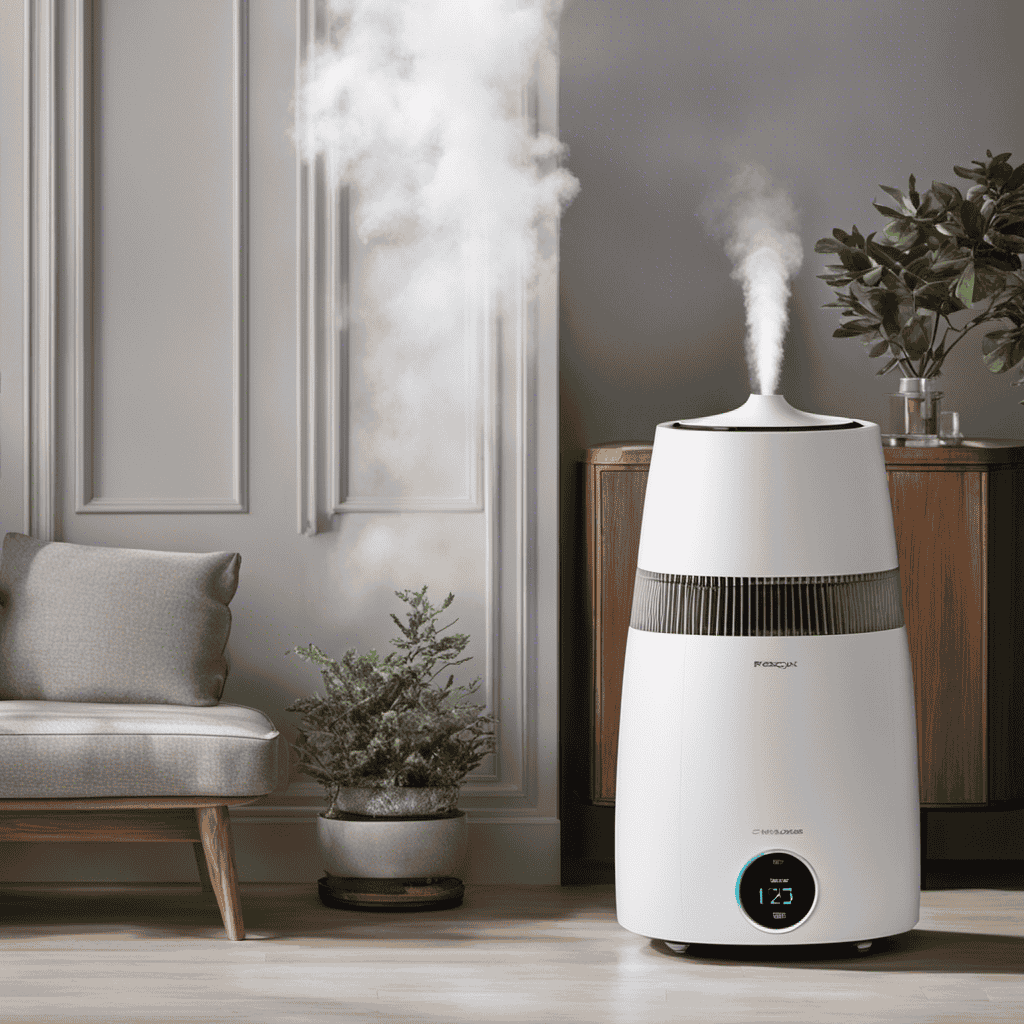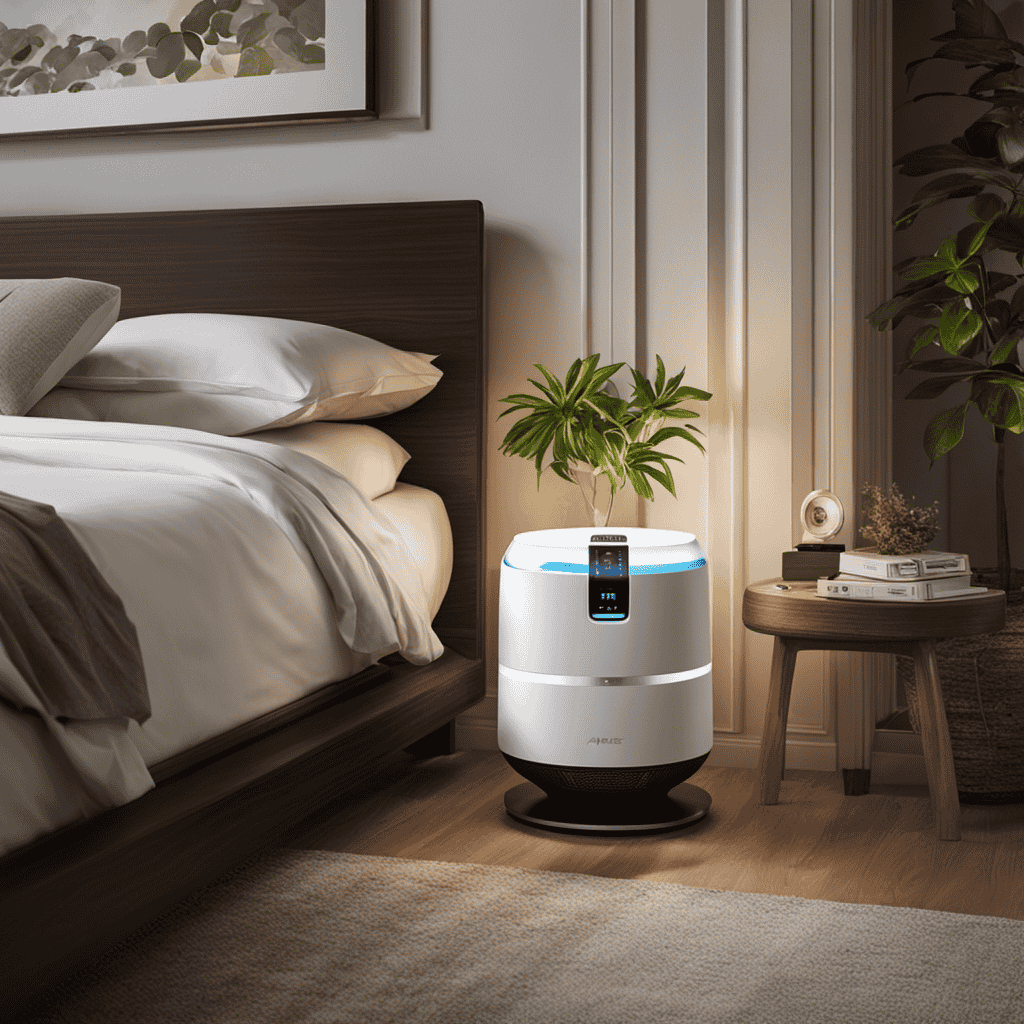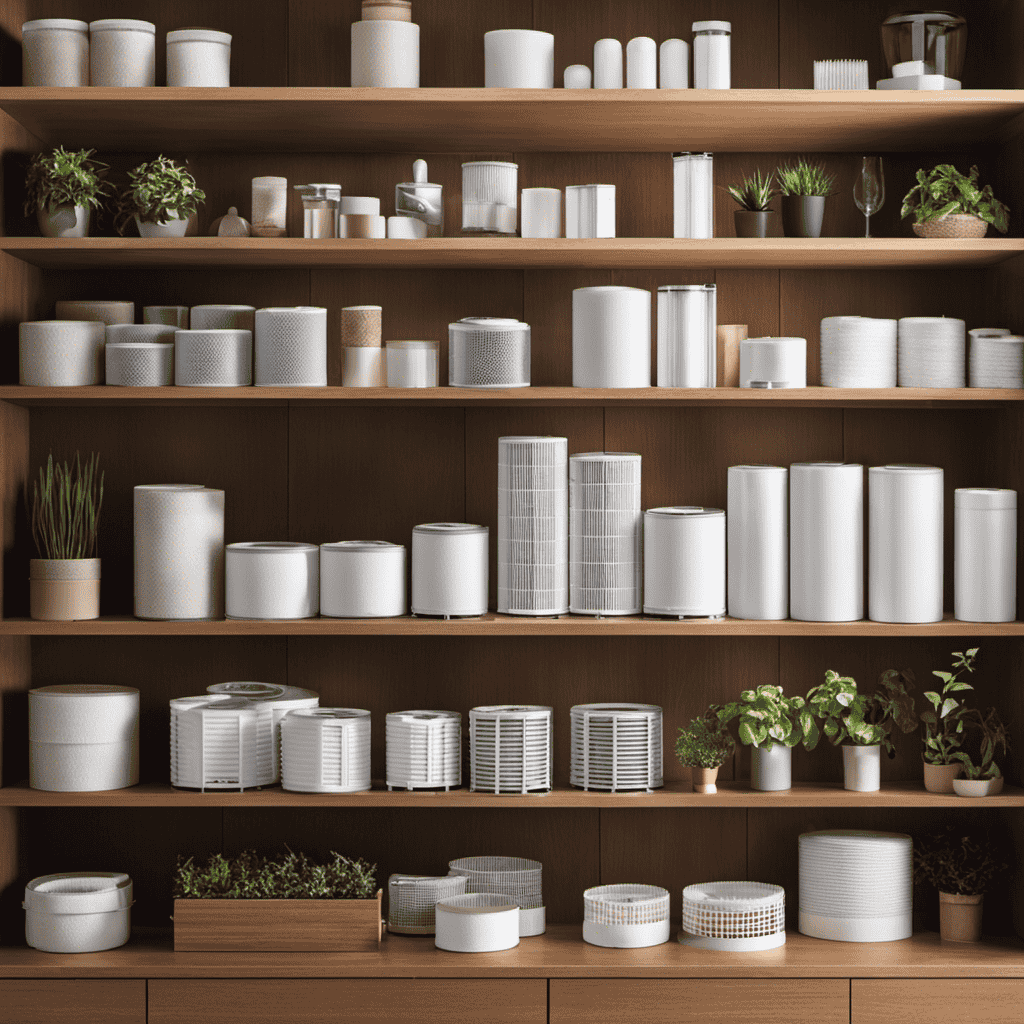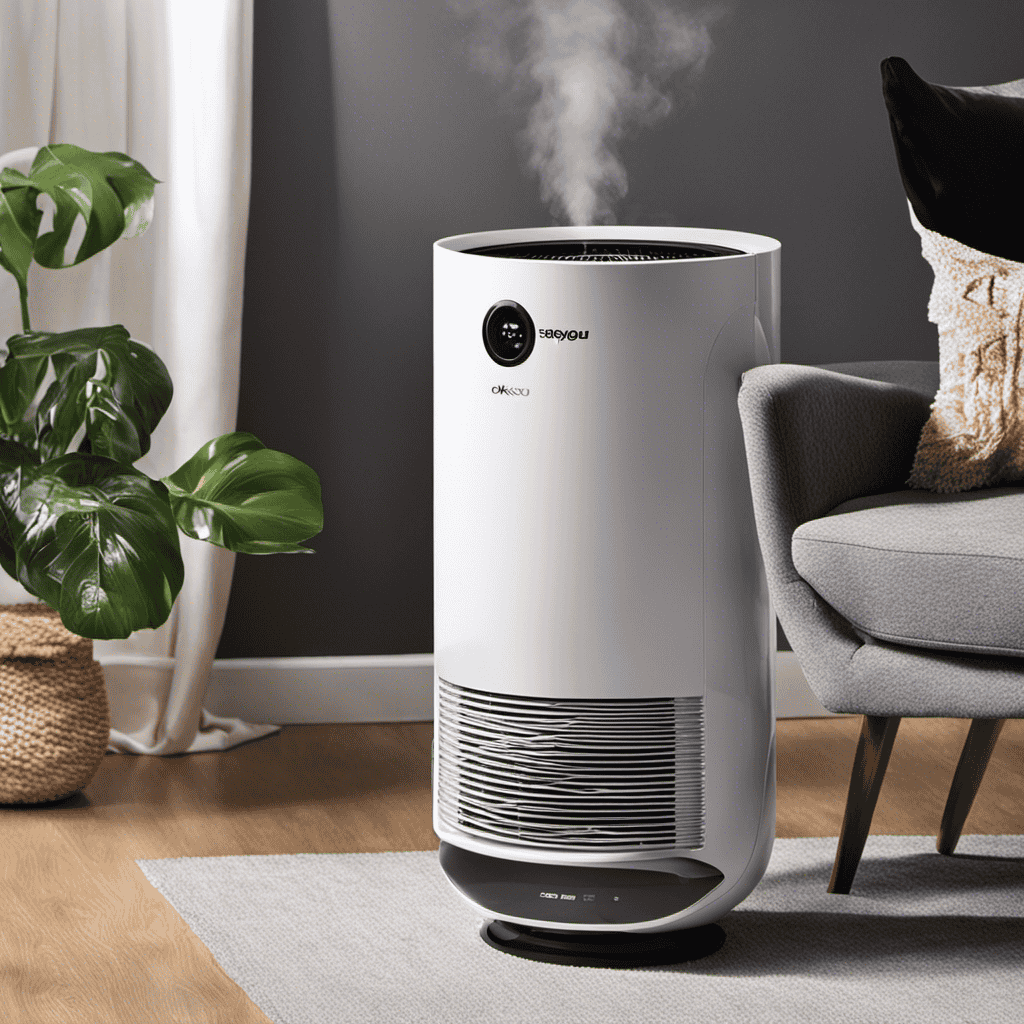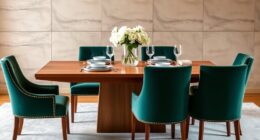As an individual who prioritizes clean and healthy indoor air, I was taken aback to discover that humidifiers can affect the effectiveness of air purifiers.
Did you know that the humidity levels in your home can directly affect how well your air purifier works?
In this article, we will explore the fascinating relationship between humidity and air purifiers, uncovering how moisture can both enhance and hinder air purification.
Get ready to dive into the technical details and discover why understanding this connection is crucial for optimizing your indoor air quality.
Key Takeaways
- High humidity levels can promote the growth of indoor pollutants like mold and dust mites, which can trigger allergies and respiratory problems.
- High humidity can make it harder for air purifiers to effectively remove airborne particles, as moisture in the air can weigh down particles and lead to filter clogging.
- Humidifiers and air purifiers work well together when compatible, as humidifiers help maintain optimal moisture levels and air purifiers capture and remove airborne particles.
- Adjusting humidifier settings is crucial for optimal air purifier performance, and maintaining a humidity level between 40-60% is ideal for respiratory health.
The Relationship Between Humidity and Air Quality
The relationship between humidity and air quality is important to understand when considering the effects of a humidifier on an air purifier. Humidity levels can have a significant impact on indoor air quality and our respiratory health. When humidity levels are too high, it creates a favorable environment for the growth of mold, dust mites, and other indoor pollutants. These pollutants can trigger allergies, asthma, and other respiratory problems. On the other hand, low humidity levels can lead to dry air, which can cause dry skin, irritated nasal passages, and respiratory discomfort.
Maintaining an optimal humidity level is crucial for creating a healthy indoor environment. Studies have shown that a relative humidity level of around 40-60% is ideal for minimizing the growth of indoor pollutants and promoting good respiratory health. This is where a humidifier can come into play. By adding moisture to the air, a humidifier can help maintain the right humidity level and reduce the concentration of indoor pollutants.
Understanding the relationship between humidity and indoor pollutants is essential when considering the effects of a humidifier on an air purifier. Next, we will explore how humidity levels impact air purifier efficiency.
How Humidity Levels Impact Air Purifier Efficiency
When it comes to air purifiers, the humidity levels in the environment can have a significant impact on their filtration effectiveness.
High humidity levels can make it harder for air purifiers to remove airborne particles effectively, as the moisture in the air can weigh down these particles and make them less likely to be captured by the filters.
Additionally, the increased moisture in the air can also lead to filter clogging, reducing the overall efficiency of the air purifier.
Humidity and Filtration Effectiveness
To improve the effectiveness of your air purifier, you should consider the impact of humidity levels.
Humidity plays a crucial role in the filtration effectiveness of air purifiers by affecting the size and behavior of airborne particles. High humidity levels can increase the moisture content in the air, causing particles to become larger and heavier. This makes it easier for the air purifier to capture and remove them from the air.
Additionally, high humidity can help reduce the concentration of airborne pollutants, such as dust, pollen, and mold spores. These pollutants tend to settle faster in humid environments, decreasing their presence in the air we breathe.
Maintaining optimal humidity levels can also have a positive impact on respiratory health, as higher humidity can help alleviate symptoms of respiratory conditions like asthma and allergies.
Overall, understanding and managing humidity levels is essential for maximizing the performance of your air purifier and promoting healthier indoor air quality.
Moisture and Filter Clogging
Moisture can cause filter clogging, reducing the effectiveness of an air purifier. Here are three reasons why moisture in air pollution can impact the performance of an air purifier:
-
Increased humidity promotes the growth of mold and mildew, which can accumulate on the air filter. This buildup can obstruct the airflow and decrease the filter’s ability to capture pollutants effectively.
-
Excessive moisture can lead to the formation of condensation, causing the filter to become damp. Damp filters are more prone to trapping particles and becoming clogged, reducing their ability to remove pollutants from the air.
-
Humidifiers, which are commonly used to add moisture to the air, can release excess moisture into the environment. This excess moisture can then be drawn into the air purifier, potentially leading to filter clogging and decreased performance.
The role of moisture in air purification is crucial, as it can greatly affect the efficiency of an air purifier in removing airborne pollutants.
The Role of Moisture in Air Purification
As I delve into the role of moisture in air purification, one important aspect to consider is the compatibility between humidifiers and air purifiers. It is crucial to understand how these two devices work together, as their compatibility can greatly impact the overall air quality in a space.
Additionally, the impact of moisture levels on air purification is a key point to explore, as excessive humidity or lack thereof can affect the effectiveness of air purifiers in removing pollutants from the air.
Humidifier and Purification Compatibility
The humidifier and air purifier work well together when they are compatible. When it comes to managing humidity and allergies, these two devices can be a powerful combination. Here are three reasons why they complement each other:
-
Optimal humidity levels: Humidity control devices like humidifiers help maintain the ideal moisture levels in the air. By adding moisture, they alleviate dryness and prevent respiratory issues caused by low humidity. This creates a more comfortable environment for individuals with allergies.
-
Reducing allergens: Air purifiers are designed to capture and remove airborne particles, including allergens like dust, pollen, and pet dander. When used in conjunction with a humidifier, they can effectively reduce the concentration of these allergens, improving indoor air quality.
-
Preventing mold growth: High humidity levels can promote the growth of mold and mildew, which can trigger allergies and respiratory problems. By controlling humidity with a humidifier, you can prevent the conditions that favor mold growth and enhance the effectiveness of your air purifier.
Impact of Moisture Levels
To maintain a comfortable environment and alleviate respiratory issues, you’ll want to ensure that your humidity levels are at the optimal range. The impact of humidity on respiratory health is significant, as both low and high humidity levels can have adverse effects. Low humidity can lead to dryness in the respiratory system, causing irritation and discomfort. On the other hand, high humidity can create a breeding ground for mold, dust mites, and other allergens, exacerbating respiratory conditions such as asthma and allergies. It is crucial to strike a balance and keep humidity levels between 40% to 60%, which is considered ideal for respiratory health. Additionally, humidity can also affect indoor plants. Too much moisture can lead to root rot and fungal growth, while too little can result in wilting and stunted growth. Maintaining appropriate humidity levels is essential for both human health and the well-being of indoor plants.
| Low Humidity | Optimal Humidity | High Humidity |
|---|---|---|
| Dryness | 40% – 60% | Mold growth |
| Irritation | Respiratory | Allergens |
| Discomfort | Health | Asthma |
Humidifier Settings and Air Purifier Performance
Adjusting the settings on your humidifier can significantly impact the performance of your air purifier. Maintaining the right level of humidity in your home is crucial for both your comfort and the effectiveness of your air purification system. Here are three key ways in which humidity control affects air purification technology:
-
Mold Prevention: High humidity levels create the perfect breeding ground for mold and mildew. These microscopic organisms can release spores into the air, which can trigger allergies and respiratory issues. By using a humidifier to keep the humidity within the recommended range of 30-50%, you can prevent the growth of mold and ensure that your air purifier can effectively filter out any existing mold spores.
-
Improved Air Quality: Dry air can cause several health problems, such as dry skin, irritated eyes, and respiratory discomfort. By using a humidifier to add moisture to the air, you can alleviate these issues and create a more comfortable living environment. This, in turn, enhances the performance of your air purifier by reducing the amount of particulate matter in the air, such as dust, pollen, and pet dander.
-
Enhanced Filtration Efficiency: When the air is too dry, it can cause airborne particles to become statically charged, making them more difficult to capture by the air purifier’s filters. By maintaining optimal humidity levels, you can prevent this static charge from building up, ensuring that your air purifier can efficiently capture and remove contaminants from the air.
How Humidifiers Can Affect Air Purifier Filters
By properly controlling the humidity levels in your home, you can ensure that your air purifier filters are not negatively impacted. Maintaining optimal humidity levels is crucial for both your health and the performance of your air purifier.
High humidity levels can create a breeding ground for mold, bacteria, and dust mites, which can trigger allergies and respiratory issues. On the other hand, low humidity levels can cause dryness, irritation, and discomfort in your respiratory system.
Using a humidifier in conjunction with an air purifier can provide several benefits. Firstly, a humidifier adds moisture to the air, which can help alleviate dryness in the nasal passages, throat, and skin. This moisture can also help to trap and remove airborne allergens, such as dust and pollen, making it easier for the air purifier to capture them. Additionally, proper humidity levels can enhance the effectiveness of the air purifier by reducing static electricity, which can attract more particles to the filter.
However, it is important to note that maintaining the right balance is key. Excessive humidity can promote the growth of mold and other allergens, while insufficient humidity may not effectively address dryness and airborne particles. It is recommended to monitor and control humidity levels using a hygrometer and follow manufacturer guidelines for both the humidifier and air purifier.
The Connection Between Humidity and Airborne Particles
In my previous discussion, I explained how humidifiers can affect air purifier filters. Now, I will delve into the connection between humidity and airborne particles.
This topic is crucial because it directly impacts not only our respiratory health but also the well-being of indoor plants.
-
Humidity and Respiratory Health:
Maintaining an optimal humidity level is essential for our respiratory health. High humidity can promote the growth of mold, dust mites, and other allergens, which can trigger respiratory issues like asthma and allergies. On the other hand, low humidity can cause dryness in the respiratory system, leading to discomfort and increased susceptibility to respiratory infections. -
Impact of Humidity on Indoor Plants:
Just as humidity affects our health, it also plays a vital role in the growth and well-being of indoor plants. Proper humidity levels help plants absorb water and nutrients through their leaves, maintain healthy transpiration rates, and prevent wilting. Insufficient humidity can cause leaf damage, hinder growth, and make plants more susceptible to pests and diseases. -
Finding the Right Balance:
Achieving the ideal humidity level in our homes is essential for both our health and the health of our indoor plants. Using a humidifier can help increase humidity during dry seasons, while proper ventilation and dehumidifiers can reduce excess humidity. Balancing humidity levels can create a comfortable and healthy environment for both humans and plants alike.
Understanding the Impact of Humidifiers on Airborne Allergens
Understanding how humidifiers impact airborne allergens is crucial for maintaining a healthy indoor environment. Humidity plays a significant role in respiratory health, and the impact of dry air on allergies cannot be overlooked. When the air is too dry, it can exacerbate allergy symptoms by causing the nasal passages and airways to become dry and irritated. By adding moisture to the air, humidifiers can help alleviate these symptoms and improve overall respiratory health.
Humidifiers work by releasing water vapor into the air, increasing the humidity levels in the surrounding environment. This added moisture helps to soothe dry nasal passages and airways, reducing inflammation and alleviating allergy symptoms such as congestion, coughing, and sneezing. Additionally, the increased humidity can also help to trap and remove airborne allergens such as dust mites, pollen, and pet dander, making the air cleaner and more breathable.
It is important to note that while humidifiers can have a positive impact on respiratory health, proper maintenance is essential. If not cleaned regularly, humidifiers can become a breeding ground for mold and bacteria, which can worsen allergy symptoms and lead to other respiratory issues. It is recommended to clean and refill the humidifier regularly to prevent the growth of harmful microorganisms.
The Effect of Humidity on Air Purifier Functionality
When it comes to air purifiers, the level of humidity in the environment can greatly impact their effectiveness.
One key point to consider is the relationship between humidity and filter efficiency. Higher humidity levels can cause filters to become saturated with moisture, reducing their ability to trap and remove airborne particles effectively.
Additionally, excessive moisture in the air can lead to mold growth, which can further compromise the performance of air purifiers.
Humidity and Filter Efficiency
To improve the efficiency of your air purifier, you’ll want to consider the impact of humidity on its filter. Humidity levels can greatly affect the performance of an air purifier and understanding this relationship is crucial for maintaining optimal air quality. Here are three key points to consider:
-
Humidity and energy consumption: High humidity levels can lead to increased energy consumption by your air purifier. This is because the filter has to work harder to capture and remove moisture from the air. By keeping humidity levels in check, you can reduce the strain on your air purifier and potentially save on energy costs.
-
Humidity and respiratory health: Excessive humidity can create a breeding ground for mold, bacteria, and other allergens. These contaminants can exacerbate respiratory conditions such as asthma and allergies. A properly functioning air purifier with a well-maintained filter can help remove these harmful particles from the air, improving indoor air quality and promoting better respiratory health.
-
Maintaining filter efficiency: High humidity levels can cause filters to become damp, reducing their efficiency in trapping airborne particles. Regularly checking and replacing filters as needed is essential to ensure optimal performance. Additionally, using a dehumidifier in conjunction with your air purifier can help regulate humidity levels and further improve filter efficiency.
Moisture and Mold Growth
If you don’t control the moisture levels in your home, you might find yourself dealing with the unwanted growth of mold. Mold thrives in damp environments, and it can cause serious health issues and damage to your property. To prevent mold growth, it is crucial to implement effective moisture control measures. This can be achieved by using dehumidifiers, improving ventilation, and addressing any leaks or water damage promptly. By maintaining optimal humidity levels, typically between 30% and 50%, you can significantly reduce the risk of mold growth. Additionally, regularly inspecting and cleaning areas prone to moisture, such as bathrooms and basements, can further aid in preventing mold. Remember, moisture control is key in keeping your home mold-free and ensuring a healthy living environment.
| Moisture Control Methods | Benefits |
|---|---|
| Use dehumidifiers | Reduces humidity levels and prevents mold growth |
| Improve ventilation | Allows moisture to escape and fresh air to circulate |
| Address leaks and water damage | Prevents moisture buildup and potential mold growth |
| Regularly inspect and clean moisture-prone areas | Removes any existing moisture and prevents mold growth |
Performance in High Humidity
Maintaining optimal humidity levels in high humidity environments is essential for preventing mold growth and ensuring a healthy living environment. When it comes to electronic devices, humidity control becomes even more crucial. Here are three reasons why using a humidifier can benefit your electronic devices:
-
Prevents static electricity: High humidity levels help to reduce static electricity build-up, which can be harmful to sensitive electronic components. By using a humidifier, you can keep static electricity at bay and protect your devices.
-
Reduces dust accumulation: Dry air tends to attract and hold onto dust particles. By increasing humidity levels with a humidifier, you can minimize dust accumulation on your electronic devices, leading to better performance and longevity.
-
Improves overall performance: Electronic devices function optimally within a specific humidity range. By maintaining the ideal humidity level, you can enhance the performance and reliability of your devices.
Using a humidifier not only benefits your electronic devices but also contributes to a healthier living environment. Now, let’s explore the importance of humidifier usage and air purifier maintenance.
Humidifier Usage and Air Purifier Maintenance
Using a humidifier with your air purifier can help maintain optimal moisture levels in your home. This combination offers several benefits for both your health and the maintenance of your air purifier.
Firstly, a humidifier helps prevent dry air in your home, which can lead to dry skin, irritated nasal passages, and even respiratory issues. By adding moisture to the air, a humidifier can alleviate these symptoms and create a more comfortable living environment.
Additionally, using a humidifier can also extend the lifespan of your air purifier. Air purifiers work more efficiently in environments with optimal humidity levels. When the air is too dry, the particles in the air can become charged and stick to surfaces, making it harder for the purifier to capture them. By maintaining proper moisture levels, the air purifier can effectively remove pollutants and allergens from the air, prolonging its effectiveness and reducing the need for frequent maintenance.
Optimizing Indoor Air Quality With Humidifiers and Air Purifiers
In my previous discussion about the usage of humidifiers and the maintenance of air purifiers, I highlighted the importance of properly using and maintaining these devices to ensure optimal indoor air quality. Now, let’s delve deeper into how the combination of humidifiers and air purifiers can work together to further improve the air we breathe.
Humidity control: Humidifiers are designed to add moisture to the air, which can be particularly beneficial during dry seasons or in regions with low humidity levels. By maintaining an optimal level of humidity, typically between 40% to 60%, we can help reduce respiratory irritation, dry skin, and even prevent the spread of airborne viruses.
Airborne pollutant removal: While humidifiers focus on increasing moisture levels, air purifiers are specifically designed to remove pollutants from the air. These devices utilize filters and other technologies to capture and eliminate contaminants such as dust, pollen, mold spores, pet dander, and even volatile organic compounds (VOCs). By combining the use of both devices, we can effectively reduce the presence of these pollutants in our indoor environment.
Allergy and asthma relief: For individuals suffering from allergies or asthma, the combination of humidifiers and air purifiers can provide significant relief. Humidifiers can help soothe dry nasal passages and respiratory discomfort, while air purifiers can remove allergens and irritants that trigger symptoms. Together, these devices create a cleaner and more comfortable indoor environment, promoting better respiratory health.
Frequently Asked Questions
Can Using a Humidifier and Air Purifier Together Improve Indoor Air Quality?
Using a humidifier and air purifier together can greatly improve indoor air quality.
The benefits of this combination include increased moisture levels, which can alleviate dryness in the air and help with respiratory issues.
Additionally, air purifiers remove pollutants and allergens from the air, further enhancing the quality of the indoor environment.
When choosing a humidifier and air purifier, it is important to consider the size of the room, the specific needs of the occupants, and the features of each device.
What Is the Ideal Humidity Level for Using an Air Purifier Effectively?
The ideal humidity level for using an air purifier effectively depends on the specific needs of your indoor environment. Generally, a humidity level between 30-50% is recommended. This range helps to prevent the growth of mold and bacteria while also optimizing the performance of the air purifier.
Maintaining proper humidity levels can enhance the benefits of using air purifiers by reducing allergens, dust, and other airborne particles.
Will Using a Humidifier Cause the Air Purifier to Work Harder?
Using a humidifier can indeed affect the performance of an air purifier. As the humidifier adds moisture to the air, the air purifier may have to work harder to remove excess humidity. This can put additional strain on the purifier’s filters and reduce its overall efficiency.
It’s important to note that while air purifiers can help improve air quality by removing pollutants, they do not typically remove humidity. Therefore, using a humidifier alongside an air purifier may require more maintenance and may impact its effectiveness.
Can a Humidifier Increase the Risk of Mold Growth in the Air Purifier?
Using a humidifier and air purifier together can have risks. One potential risk is an increased risk of mold growth in the air purifier. This is because humidifiers add moisture to the air, creating a more favorable environment for mold to grow.
Mold can negatively impact the performance of an air purifier and potentially spread throughout the room. It’s important to monitor humidity levels and regularly clean and maintain both the humidifier and air purifier to minimize the risk of mold growth.
Is It Necessary to Use a Humidifier and Air Purifier Simultaneously in All Seasons?
Is it really necessary to use a humidifier and air purifier together in all seasons? Well, let’s consider the pros and cons.
Using both can improve air quality by adding moisture and filtering out pollutants. However, this combo can also increase energy consumption.
Conclusion
Well, after diving deep into the world of humidifiers and air purifiers, it’s clear that these two devices have quite the relationship.
Who would have thought that something as innocent as a humidifier could actually impact the efficiency of an air purifier? But hey, that’s just how it goes in the world of indoor air quality.
The moisture from a humidifier can affect the performance of an air purifier, messing with its filters and even its ability to tackle airborne allergens.
So, if you want to optimize your indoor air quality, make sure you’re using both devices in harmony.
